The Aircraft Elevator Market is estimated to be valued at USD 1.3 billion in 2025 and is projected to reach USD 2.4 billion by 2035, registering a compound annual growth rate (CAGR) of 6.5% over the forecast period.
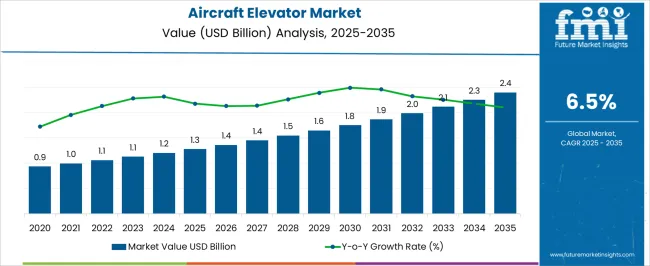
| Metric | Value |
|---|---|
| Aircraft Elevator Market Estimated Value in (2025 E) | USD 1.3 billion |
| Aircraft Elevator Market Forecast Value in (2035 F) | USD 2.4 billion |
| Forecast CAGR (2025 to 2035) | 6.5% |
The Aircraft Elevator market is experiencing steady growth driven by increasing demand for efficient control surfaces in modern aircraft, particularly for improved aerodynamic performance and flight safety. The market is supported by rising commercial air travel, expanding defense aviation programs, and growing investments in aircraft manufacturing and retrofitting. Technological advancements in materials, precision engineering, and automated manufacturing processes have further enhanced product reliability, longevity, and performance.
The trend toward lightweight, fuel-efficient, and aerodynamically optimized aircraft has led to increased integration of advanced aircraft elevators across both commercial and military aircraft fleets. Growing awareness of flight safety regulations and the adoption of automated control systems have further reinforced demand.
As aviation operators focus on fleet modernization and performance optimization, opportunities for both new aircraft production and aftermarket retrofits are expected to expand The market outlook suggests continued adoption of advanced aircraft elevators, supported by global growth in air travel, evolving defense requirements, and advancements in engineering design and production capabilities.
The aircraft elevator market is segmented by type of product, type of aircraft, type of wing, and geographic regions. By type of product, aircraft elevator market is divided into Horizontal Stabilator Aircraft Elevator, Elevons Aircraft Elevator, and Levcons Aircraft Elevator. In terms of type of aircraft, aircraft elevator market is classified into Narrow Body, Wide Body, Freighter, and Regional Jet. Based on type of wing, aircraft elevator market is segmented into Fixed-Wing Aircraft and Rotary Wing Aircraft. Regionally, the aircraft elevator industry is classified into North America, Latin America, Western Europe, Eastern Europe, Balkan & Baltic Countries, Russia & Belarus, Central Asia, East Asia, South Asia & Pacific, and the Middle East & Africa.
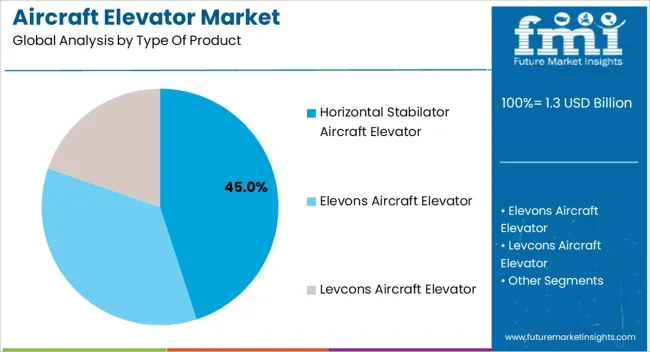
The Horizontal Stabilator Aircraft Elevator product type is projected to account for 45.00% of the total market revenue in 2025, making it the leading product type. This dominance is being attributed to its ability to provide enhanced pitch control and stability across a wide range of aircraft sizes and mission profiles. The segment has benefited from the growing emphasis on fuel efficiency, aerodynamic performance, and ease of integration with flight control systems.
Adoption has been accelerated in modern commercial and military aircraft where precision control is critical for both safety and performance. Horizontal stabilator elevators allow for more streamlined aerodynamic profiles and can accommodate software-assisted flight control systems, which further enhances operational efficiency.
The growth of this segment is reinforced by rising investments in aircraft upgrades and the increasing demand for high-performance control surfaces capable of supporting advanced flight maneuvers As aircraft manufacturers continue to prioritize aerodynamic optimization and safety, the Horizontal Stabilator segment is expected to sustain its market leadership.
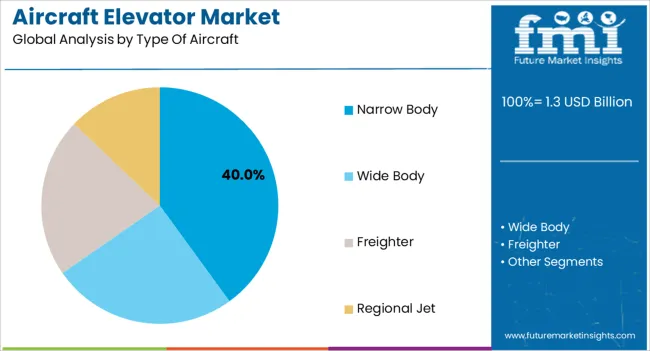
The Narrow Body aircraft type is anticipated to hold 40.00% of the Aircraft Elevator market revenue in 2025, establishing it as the leading aircraft type segment. This leadership is being driven by the widespread production and operation of narrow body commercial jets, which are favored for regional and short-haul travel due to cost efficiency and operational flexibility. The segment has benefited from rising air passenger traffic, fleet expansions, and airline modernization programs, which have fueled demand for reliable and high-performance elevator systems.
Narrow body aircraft require precise control surfaces to optimize fuel consumption, ensure passenger comfort, and maintain regulatory compliance. The ability to integrate advanced aircraft elevators without significant modifications to existing airframes has also supported adoption.
Furthermore, the growing emphasis on retrofit programs and fleet upgrades has reinforced the dominance of this segment Continued expansion in regional and domestic air travel, coupled with technological enhancements in flight control systems, is expected to drive sustained growth for narrow body aircraft elevator installations.
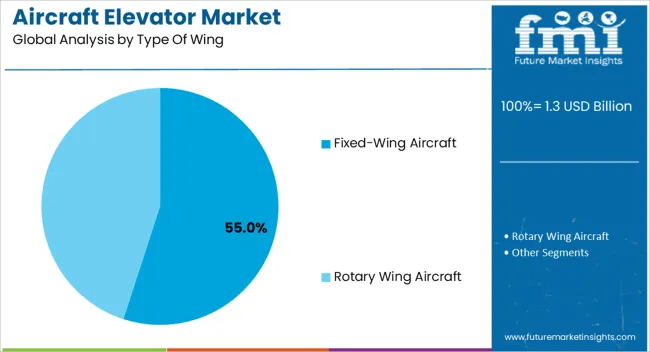
The Fixed-Wing aircraft type is projected to capture 55.00% of the Aircraft Elevator market revenue in 2025, positioning it as the largest end-use segment. This predominance is being attributed to the widespread application of fixed-wing platforms in commercial aviation, cargo transport, and defense operations. Fixed-wing aircraft demand reliable and precise elevator systems to maintain stability, enhance maneuverability, and optimize aerodynamic efficiency.
The segment has benefited from advancements in material science, weight reduction techniques, and precision manufacturing, which allow elevators to perform effectively under diverse operational conditions. Adoption has also been supported by the growing global fleet of fixed-wing aircraft and increased investment in both new production and aftermarket upgrades.
Regulatory focus on flight safety and operational reliability has further reinforced demand for high-quality elevators in fixed-wing platforms As manufacturers and operators continue to emphasize fuel efficiency, performance, and safety, the Fixed-Wing segment is expected to retain its leading position in the aircraft elevator market.
An Aircraft Elevator is considered to be a vital component of an aircraft’s primary flight control systems. Aircraft elevator is more often situated at the rear end of an aircraft (except in rotary wing aircrafts) on each side of the fin in the tail. In some airplanes the aircraft elevator is located on the front side, ahead of the wings.
Aircraft elevator is used to control the pitch of an aircraft which helps in maintaining the aircraft nose up or down in order to make the aircraft climb or decent. During the take-off of the flight, the aircraft elevator is raised and during the landing of the flight, the aircraft elevator is lowered.
Aircraft elevator plays an important role in generating higher lift and drag force on the wings of the aircraft. Growing aerospace industry with increasing number of aircraft in several countries across the globe is estimated to drive the demand for aircraft elevator during the forecast period. This in turn is anticipated to contribute to the global aircraft elevator market.
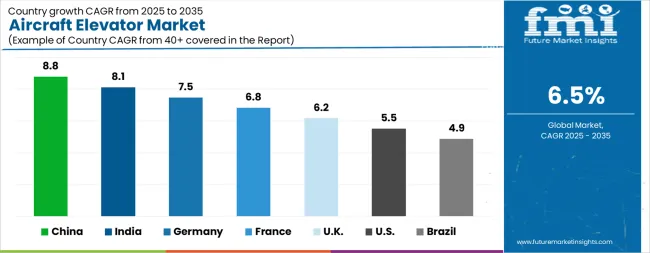
| Country | CAGR |
|---|---|
| China | 8.8% |
| India | 8.1% |
| Germany | 7.5% |
| France | 6.8% |
| UK | 6.2% |
| USA | 5.5% |
| Brazil | 4.9% |
The Aircraft Elevator Market is expected to register a CAGR of 6.5% during the forecast period, exhibiting varied country level momentum. China leads with the highest CAGR of 8.8%, followed by India at 8.1%. Developed markets such as Germany, France, and the UK continue to expand steadily, while the USA is likely to grow at consistent rates. Brazil posts the lowest CAGR at 4.9%, yet still underscores a broadly positive trajectory for the global Aircraft Elevator Market. In 2024, Germany held a dominant revenue in the Western Europe market and is expected to grow with a CAGR of 7.5%. The USA Aircraft Elevator Market is estimated to be valued at USD 473.4 million in 2025 and is anticipated to reach a valuation of USD 810.5 million by 2035. Sales are projected to rise at a CAGR of 5.5% over the forecast period between 2025 and 2035. While Japan and South Korea markets are estimated to be valued at USD 57.8 million and USD 41.2 million respectively in 2025.
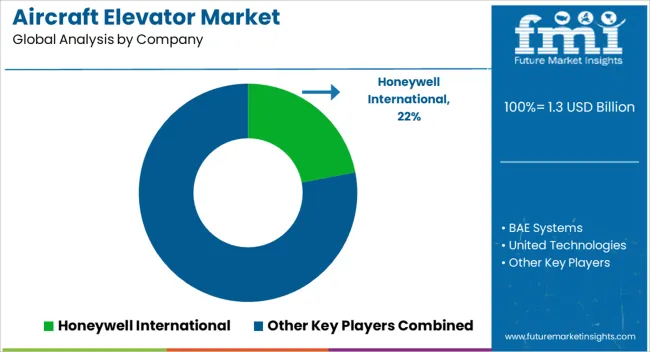
| Item | Value |
|---|---|
| Quantitative Units | USD 1.3 Billion |
| Type Of Product | Horizontal Stabilator Aircraft Elevator, Elevons Aircraft Elevator, and Levcons Aircraft Elevator |
| Type Of Aircraft | Narrow Body, Wide Body, Freighter, and Regional Jet |
| Type Of Wing | Fixed-Wing Aircraft and Rotary Wing Aircraft |
| Regions Covered | North America, Europe, Asia-Pacific, Latin America, Middle East & Africa |
| Country Covered | United States, Canada, Germany, France, United Kingdom, China, Japan, India, Brazil, South Africa |
| Key Companies Profiled | Honeywell International, BAE Systems, United Technologies, Moog Inc., Nabtesco Corporation, Liebherr Group, and Harbin Hafei Airbus Composite Manufacturing Centre |
The global aircraft elevator market is estimated to be valued at USD 1.3 billion in 2025.
The market size for the aircraft elevator market is projected to reach USD 2.4 billion by 2035.
The aircraft elevator market is expected to grow at a 6.5% CAGR between 2025 and 2035.
The key product types in aircraft elevator market are horizontal stabilator aircraft elevator, elevons aircraft elevator and levcons aircraft elevator.
In terms of type of aircraft, narrow body segment to command 40.0% share in the aircraft elevator market in 2025.






Our Research Products

The "Full Research Suite" delivers actionable market intel, deep dives on markets or technologies, so clients act faster, cut risk, and unlock growth.

The Leaderboard benchmarks and ranks top vendors, classifying them as Established Leaders, Leading Challengers, or Disruptors & Challengers.

Locates where complements amplify value and substitutes erode it, forecasting net impact by horizon

We deliver granular, decision-grade intel: market sizing, 5-year forecasts, pricing, adoption, usage, revenue, and operational KPIs—plus competitor tracking, regulation, and value chains—across 60 countries broadly.

Spot the shifts before they hit your P&L. We track inflection points, adoption curves, pricing moves, and ecosystem plays to show where demand is heading, why it is changing, and what to do next across high-growth markets and disruptive tech

Real-time reads of user behavior. We track shifting priorities, perceptions of today’s and next-gen services, and provider experience, then pace how fast tech moves from trial to adoption, blending buyer, consumer, and channel inputs with social signals (#WhySwitch, #UX).

Partner with our analyst team to build a custom report designed around your business priorities. From analysing market trends to assessing competitors or crafting bespoke datasets, we tailor insights to your needs.
Supplier Intelligence
Discovery & Profiling
Capacity & Footprint
Performance & Risk
Compliance & Governance
Commercial Readiness
Who Supplies Whom
Scorecards & Shortlists
Playbooks & Docs
Category Intelligence
Definition & Scope
Demand & Use Cases
Cost Drivers
Market Structure
Supply Chain Map
Trade & Policy
Operating Norms
Deliverables
Buyer Intelligence
Account Basics
Spend & Scope
Procurement Model
Vendor Requirements
Terms & Policies
Entry Strategy
Pain Points & Triggers
Outputs
Pricing Analysis
Benchmarks
Trends
Should-Cost
Indexation
Landed Cost
Commercial Terms
Deliverables
Brand Analysis
Positioning & Value Prop
Share & Presence
Customer Evidence
Go-to-Market
Digital & Reputation
Compliance & Trust
KPIs & Gaps
Outputs
Full Research Suite comprises of:
Market outlook & trends analysis
Interviews & case studies
Strategic recommendations
Vendor profiles & capabilities analysis
5-year forecasts
8 regions and 60+ country-level data splits
Market segment data splits
12 months of continuous data updates
DELIVERED AS:
PDF EXCEL ONLINE
Aircraft Cabin Environment Sensor Market Forecast and Outlook 2025 to 2035
Aircraft Flight Control System Market Size and Share Forecast Outlook 2025 to 2035
Aircraft Electric Motor Market Forecast Outlook 2025 to 2035
Elevators and Escalators Market Analysis - Size, Share, and Forecast Outlook 2025 to 2035
Aircraft Cooling Turbines Market Size and Share Forecast Outlook 2025 to 2035
Aircraft Smoke Detection and Fire Extinguishing System Market Size and Share Forecast Outlook 2025 to 2035
Aircraft Hose Fittings Market Size and Share Forecast Outlook 2025 to 2035
Aircraft Cabin Interior Market Size and Share Forecast Outlook 2025 to 2035
Aircraft Galley Systems Market Size and Share Forecast Outlook 2025 to 2035
Aircraft Interior Lighting Market Size and Share Forecast Outlook 2025 to 2035
Aircraft Battery Market Size and Share Forecast Outlook 2025 to 2035
Aircraft Floor Panels Market Size and Share Forecast Outlook 2025 to 2035
Aircraft Fuel Systems Market Size and Share Forecast Outlook 2025 to 2035
Aircraft Lubricant Market Size and Share Forecast Outlook 2025 to 2035
Aircraft Seat Market Size and Share Forecast Outlook 2025 to 2035
Aircraft Ground Support Equipment Market Size and Share Forecast Outlook 2025 to 2035
Aircraft Maintenance, Repair and Overhaul Market Size and Share Forecast Outlook 2025 to 2035
Aircraft Actuators Market Size and Share Forecast Outlook 2025 to 2035
Aircraft Weapons Market Size and Share Forecast Outlook 2025 to 2035
Aircraft Lighting Market Size and Share Forecast Outlook 2025 to 2035

Thank you!
You will receive an email from our Business Development Manager. Please be sure to check your SPAM/JUNK folder too.
Chat With
MaRIA